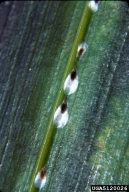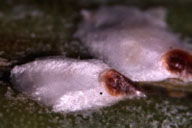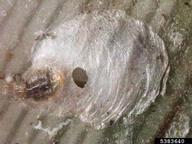Magnolia white scale
Pseudaulacaspis cockerelli (Cooley) (Hemiptera: Diaspididae)
Orientation to pest
Magnolia white scale, Pseudaulacaspis cockerelli (Cooley), (known formerly as the false oleander scale) is an invasive Asian scale found in the southern United States. It is one of the most polyphagous insects known, reported from 75 different plant families.
Hosts commonly attacked
Common host plants include magnolia (Magnolia), bird of paradise (Strelitzia), oleander (Nerium oleander L.), azalea (Azalea), plumeria (Plumeria), mango (Mangifera indica L.), kukui (Aleurites moluccana [L.] Willd.), cycads and palms.
Distribution
This scale is likely native to southern Asia, but is invasive in many parts of the world, including Hawaii and Puerto Rico. In North America, it is invasive in the southern United States (Florida to Maryland, west to Texas and Kansas).
Images of magnolia white scale
| Figure 1. Adults of magnolia white scale, Pseudaulacaspis cockerelli, on areca palm (Areca sp.) (left); close up of magnolia white scale adults (right) | Figure 2. Parasitoid emergence hole in cover of white magnolia scale | |
Important biological control agents related to this pest species
Some specialized parasitoids of this scale are known from its native south Asian range, but none have been used for biological control of this scale in North America.
Web links for information on magnolia white scale
- Entomology Publication #EENY-149 | University of Florida IFAS Extension EDIS
- Fact Sheet from Crop Knowledge Master | EXTension ENTOmology and University of Hawaii-CTAHR IPM
- Species Catalog on ScaleNet
Complete list of all recorded natural enemies, hosts, and distribution records; also an index to all publications on this species
Articles
- Rosen, D. and P. DeBach. 1986. Three new species of Aphytis (Hymenoptera: Aphelinidae), parasites of Pseudaulacaspis spp. (Homoptera: Diaspididae) in India and Australia. Entomophaga 31: 139-151.






